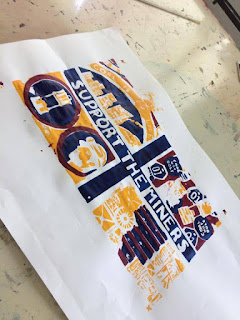On 29th and 30th of March, I progressed
and developed my final outcome tracings to be placed into the Textiles studio
to be exposed and to be transferred onto 4 layered screens. The design process
has been captured previously through my tracings and visual sheet to capture
the final outcome of the design. Previously each tracing has been measured accurately
and layered well so that the outcome would be prepared and transferred onto
screens accurately to be exposed well and to capture the colour scheme
effectively. For the design surface it incorporates a series of elements taken
from the mining community with fonts, illustrations and slogans. It has been
divided with the national flag and captures the separation of each surface
design well and effectively. The process of the design included intricate
details of industrial landscapes and characteristics which was a problem in which
I felt was going to happen through the exposed screens. As previous projects
have displayed problems with capturing intricate details, I knew this was going
to be a reassured problem when being captured through the final piece. To ensure
and problem solve before the task, the screen tracings were placed onto the
light box and developed textured outlines further through the surface and
equipment of permanent marker pens. Due to use of this equipment caused a
health and safety hazard which would impact the working environment. To solve
the problem the pens were placed into a well air conditioned room filled with
clean air to avoid the smell and chemical aspect of the design surface. Next I focused
with highlighting the areas that were exposed less effectively and were
reinforced through the repeated equipment. Once the designs they were placed
into the Textiles to be exposed and transferred onto surface design. These
workshop outcomes and progression have allowed me to plan, prepare and organise
solutions to be transferred into the Textiles workshop to be expanded further
and develop my project outcome. Also the task has allowed me to problem solve
practically and theoretically within the workshop task and before the
progression into the studio. The task has also allowed me to demonstrate
practical skills within the workshop of Textiles to progress to the next stage
of my task through development of samples and production. To prepare for the
task previously, the chosen screens were stripped with Pregosol to remove
excess design surfaces from past samples and to create a clean appearance. For the
screens to work I decided to use same length and scale to ensure the layered
screens would be placed accurately onto the surface design. Next the preogsol
was left onto the surface for 10 minutes and was washed away from the surface
to create the design and outcome. Once the screens were dried, Emulsion was
placed onto the surface smoothly to create the basic layer and surface for the
design to be exposed. For the surface to work and to be placed accurately onto
the surface, the emulsion was transferred into a dark room so that the surface wouldn’t
be exposed. Once the screens were captured they were placed in the drying rack
left for 24 hours to be used and exposed. For the exposure stage the designs
were transferred onto the machine which was an area and problem I faced. Previously
within past projects the screen layers haven’t matched up well causing an inaccurate
appearance and misplaced surface designs. This was a recurring problem faced
during my experimentation within Textiles and I wanted to resolve this situation
to create and accurate outcome. To solve the problem I decided to place magic
tape around the surface corners of the tracing to identify the areas and give guidance
when placing the tracings onto the surface. As the scale of the tracing
outlines were all equal it has worked well within the surface and produced a
more time efficient progression within the Textiles studio. To reassure the
surface design worked well and had an accurate appearance, the screen equipment
was also repeated with the same guideline of tape to ensure effective layout. Both
of these aspects contributed to the accuracy of my layered screens. Next they
were exposed through the machine 4 times to capture each layer and was then
placed into the wash room to remove the emulsion the reveal the design outcome.
When the screens were placed in the jet wash a problem was faced with the
intricate designs. Due to the power and force of the Jet Wash it caused damage
to the screens causing an eroded piece and elements outside of the designs that
effected the overall impact of the appearance. This was a recurring problem faced
within Textiles and an area in which needed to be resolved to complete the progression
of the project. All the screens were damaged through the process which was a
major problem for the design. However to solve the problem and reflect within this
issue the screens were used to generate paper samples to show my progression
and development through the project. It has allowed me to identify the areas in
which need to be resolved and how I can improve within the problem solving gained.
All the screen samples have been generated and displayed below with annotation
placed into my technical file. I have shown diversity through divided layers
and combining the screens together. Also the materials used are listed below. Through
the sampling I stripped the screens again and used pregasol to remove the
damaged designs. Then they were covered with emulsion and developed again
within my independent study to capture the screens again.
 |
| Exposing Screens Timeline |
Next I am going to be exposing my screens again through my
independent study to produce and effective and accurate layers of screens.
 |
| Dyes Used |



























No comments:
Post a Comment